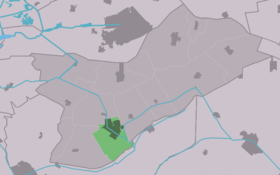Gorredijk
| (Dutch) Gorredijk (West Frisian) De Gordyk |
|||
|---|---|---|---|
| Town | |||

Postcard photo of Gorredijk, 1914
|
|||
|
|||
 |
|||
| Country |
|
||
| Province |
|
||
| Population | |||
| • Total | 7,369 | ||
Gorredijk (West Frisian: De Gordyk) is the biggest town in the municipality of Opsterland, in the Dutch province of Friesland. Gorredijk had a population of 7,369 in 2014.
Before the 1600s, the wide area surrounding modern-day Gorredijk was populated by communities contenting themselves with shepherding, beekeeping, haying and farming; producing buckwheat, oat, rye, peas, beans, flax and various herbs. Compared to the present day, keeping cattle was a relatively uncommon phenomenon. Like in much of southeast Friesland, the soil between Gorredijk and Jubbega consisted of raised bog, which was excavated for peat. Around the turn of the 17th century, the value of this fossil fuel lured businesspeople like Jonker Dekema and the so-called Gentlemen Associates, who made an "industry" out of selling the peat and ended up owning vast stretches of land—a good example being nearby Jonkersland. The year 1631 saw the completion of the Opsterlandse Compagnonsvaart, a 34 km (21 mi) long canal from Gorredijk to Smilde, in the neighboring province of Drenthe, to facilitate the transport of peat out of the area by way of barge. Soon after, the first migrant workers' houses were being constructed along the canal and a Hooghout bridge was built across, signifying the beginning of peat colony de Gordyk.
Around the start of the Third Anglo-Dutch War in 1672, a sconce was erected nearby, simply referred to as de Skâns, presently the name of the town's cultural center. Gorredijk evolved into a market town in 1694, when the first weekly market (the Gordykster Merke) and annual cattle market (which ended in the 1980s) were organized. In the early 1700s, the neighboring settlement of Kortezwaag was merged into Gorredijk. At the end of the 18th century, there was a small influx of Jewish migrants. These people had founded a synagogue, school and a small Jewish cemetery by 1817. Few would return after the end of the war however. The last victim of the Second World War in Gorredijk was Gerke Numan, a member of the Dutch resistance. He and ten others had been tasked with preventing the retreating Germans from blowing up the main drawbridge in Gorredijk, so the First Canadian Army could give chase. Numan was killed in a firefight that ensued and the bridge was destroyed. The current bridge, installed during the post-war reconstruction, was named in his honor.
...
Wikipedia


